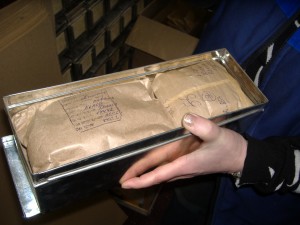- “Coffee and cocoa yes, coca no.”
- 1st All Africa Horticulture Congress.
- Carotenoid and vitamin content of Micronesian atoll foods: Pandanus (Pandanus tectorius) and garlic pear (Crataeva speciosa) fruit.
- A Family Year: a 5-part television series focusing on the health and environmental threats facing families in Russia and Central Europe.
- Natbar Sarangi: one man Indian rice genebank.
- Climate change “might hinder coconut production“.
Bush wild tomatoes
Someone called James Sultana emailed us to ask: “Where can get some bush wild tomatoes”.
I was forced to reply in pedant mode:
Could you be a little bit more specific? What do you mean by a “bush
wild tomato”? A wild relative of the tomato? Or some other species
(maybe Australian?) that goes by that name?
Alas, Jim hadn’t entered his email correctly in our contact form, so my reply bounced right back. So, if you’re reading this, Jim, answer the question and we’ll do our best to help. And the rest of you, what might a “bush wild tomato” be?
Nibbles: French fries, Maple syrup, Cooking heirlooms, Salmon, Ancient booze, Rice domestication
- India finally arrives, gets french fries.
- Sophisticated urbanites tap maples.
- Raise a rare heirloom breed. Then cook it.
- “Some might be hoping he will predict a return to the glory days of the “truly unique” strain of Petitcodiac salmon, which now likely exists only in a gene bank at the Mactaquac Fish Hatchery at this point.”
- Boffins identify world’s first cocktail.
- How people turned from nut collectors into rice farmers in China.
- Hungarians sacrificed dogs.
Virtual visit to VIR
Click on the picture for some impressions from my recent visit to the N.I. Vavilov Institute Research Institute for Plant Industry in St Petersburg, Russia on the occasion of a SEEDNet meeting. A veritable monument to agrobiodiversity. And don’t forget Nikolai Ivanovich has a voice.
Nibbles: Cacao, Profits, Biochar, Biochar, Museum, Fish, Cognac
- Take a tour around the world’s most important cacao germplasm collection.
- “[D]iversified systems were more profitable than monocropping,” but read the whole paper. You have 30 days, free.
- Open source science to measure the impact of biochar.
- “Pro-biochar activists can be as silly as these anti-biochar activists.” Well, duh. But thanks for explaining.
- Gehry builds Panama a Museum of Biodiversity, but seems to forget about agriculture.
- Kano’s fish market takes a hit.
- All about rancio.
